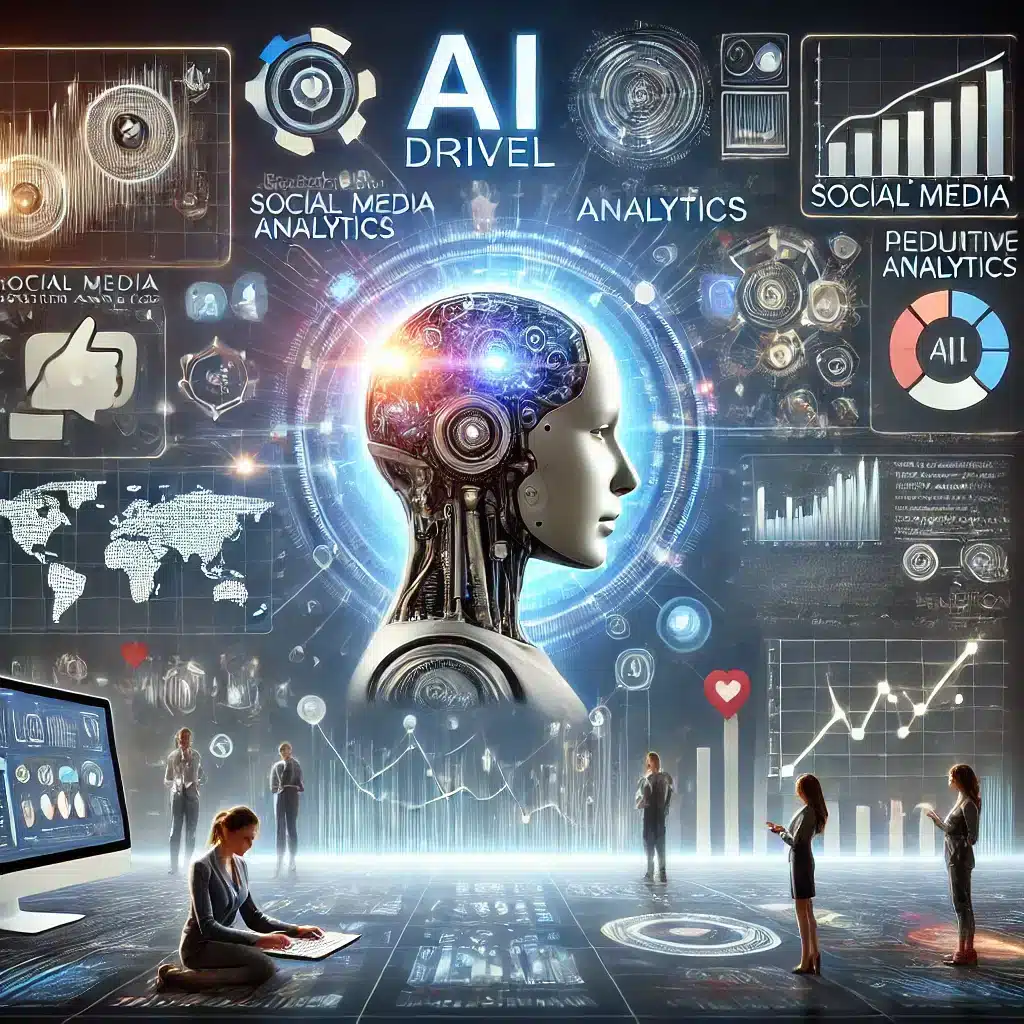Artificial intelligence and creative marketing are constantly evolving in a manner that looks increasingly pertinent to the future of ad design and copywriting. Emerging businesses attempt innovative strategies to attract audience attention, which is gradually changed by AI technologies. In this regard, this article looks at how AI can innovate ad design and copywriting in creative marketing and goes further to outline its role, benefits, challenges, and future trends.
What is the Role of AI in Marketing and Advertising?
Understanding AI and its Impact on Creative Marketing
AI plays a very important role in marketing and advertising: applying data-driven decision-making and improving the creative process. By applying data to determine patterns and trends in creative marketing, marketing teams can refine their marketing strategies according to needs. Therefore, by maximizing AI algorithms, businesses make more targeted ads for specific audiences, to enhance ad performance. Applying AI in marketing does not only mean automation but also enhancement of human creativity using the most advanced tools from AI to analyze consumer behavior and preferences.
Examples of AI Used in Advertising
There are countless use cases of AI in advertising to show its flexibility and its impact on creative marketing. For instance, you can analyze user engagement metrics on AI-powered ad platforms, optimizing your ad spending and targetting the right audience. Generative AI can also produce multiple versions of an ad, thus allowing marketers to test multiple different creative assets efficiently. Besides, AI tools will be able to help in content writing as they create wonderful copywriting that corresponds to the brand tone and messaging. The examples shown above show how AI can benefit marketing campaigns by making campaigns more relevant to consumers and fun.
The Power of AI in Enhancing Ad Performance
Undoubtedly, the capabilities of AI can excel in enhancing ad performance. AI technologies adopted by marketers can let them predict which ads do better based on historical data and real-time analytics. With AI’s assistance, marketers can also determine the right channels of distribution so they can use their resources wisely. Moreover, the fast generation of ad copy, as well as its versions, gives room for quick testing, thus leading to greater chances of success in campaign results. Finally, with AI in advertising, results indicate more engagement at much higher conversion rates and more effective use of marketing budgets.
How Can Generative AI Transform Ad Creative?
Leveraging Generative AI for Innovative Ad Campaigns
Generative AI is redefining the creative ad space by using generative AI tools. Marketers can develop innovative, unique ad campaigns to stand out from the crowded digital advertising space for bold and captivating ad creatives. The AI tools help analyze existing ad content and consumer data to generate fresh ideas and concepts that best align with the brand objectives. This overall streamlines the creative process and enhances the overall quality of ad creatives by incorporating data-driven insights.
Applications of Generative AI in Marketing
The applications of generative AI are diverse and varied including generating ad copy appealing to the target audience, aesthetic graphics, and much more. Generative AI can help in boosting marketing campaign impacts by creating personalized ads based on specific consumer preferences, for greater engagement. This is because the scale at which generative AI can create creative assets allows marketing teams to try more campaign strategies simultaneously, thus leading to a lot more dynamic approach to advertising.
Case Studies: Successful Cases of Generative AI in Advertising
There are great examples of how a few brands have successfully applied generative AI to advertising, which could revolutionize a campaign in ads. A leading beverage company successfully used generative AI to make personalized video ads according to viewer preference. It managed to increase views by a considerable number and recall brand value. A second case study centered around an application of a generative AI tool to create a large variety of ads for a fashion retailer, which helped the company reach many demographics at once. The case studies illustrate how generative AI can lead to creative breakthroughs and measurable success in advertising.
What Are the Benefits of Using AI Tools for Copywriting?
AI Tools for Efficient Content Creation in Marketing
AI copywriting tools are no longer optional but necessary for the marketing environment as they present a wide range of benefits and make content creation easier. They help save valuable time and effort when creating marketing copies of high quality. The automatic removal of recurring writing tasks and helping of the marketing team to focus on strategic initiatives and creative thinking gives them more room for such brain-storming. Besides, AI can help determine that brand messaging is uniform and consistent across all platforms and strengthens brand identity. Thus, the use of AI in copywriting results in a more streamlined and efficient process of content marketing and greater productivity on the part of marketing teams.
How AI Can Help Improve Copywriting Quality
AI also enhances quality copywriting based on data-related insights and ideas. An advanced AI system can compare successful copy based on performance criteria from many different campaigns and provide recommendations for improvement. Therefore, marketers improve their messaging so it better speaks to the intended targets. Lastly, AI can aid in grammar, tone, and style checks, ensuring that your finalized copy meets brand standards. In this way, marketing professionals can use AI to produce high-quality, engaging content that inspires action and conversion.
Examples of AI Tools for Ad Copy
Some AI tools for ad copy have exclusive features that streamline the workflow of copywriting. Tools like Copy.ai and Jasper use AI in generating creative ad copies making it easier for marketers to rapidly brainstorm ideas. Platforms like these help produce different copies suited to a population or platform, to implement targeted marketing strategies. Tools like Grammarly and Hemingway provide instant real-time feedback on the writing style helping marketers in perfecting their copy to full effect. The AI tools above in advertising copy illustrate what might be possible to make marketing more efficient and creative.
What Are the Challenges of Implementing AI in Ad Design?
Common Obstacles in Using AI for Creative Marketing
While AI offers a broad range of advantages in advertising, marketers face several issues when applying AI technologies. First is the integration cost where a business must incur the initial cost of the AI tools. This can present a hurdle to small enterprises. There may be a learning curve about how AI systems are correctly applied, which quite often leads to resistance from marketing teams accustomed to the traditional ways. Furthermore, data security is an issue that majority of the people are still unable to navigate through.
Understanding the Limitations of AI in Ad Creation
While AI has advanced much in ad creation, a bit of its limitations need to be reminded. The AI system fails to understand the human emotions and cultural contexts that can limit the creatives in an advertisement. Moreover, sometimes using AI results in less creativity because AI-generated content is likely to copy what has been existing rather than question it. Advertising marketers should balance the application of AI with human insight and creativity so that their advertisements will ring authentically among audiences.
How to Face Challenges of AI in Advertising?
To overcome the challenges posed by the application of AI in advertising, marketers have to employ an incremental approach to integrate AI tools into their workflow. Making pilot projects is an excellent way to help teams get familiar with AI technologies since the risk is minimal. Training and education provided to the marketing teams on the AI tools can also enable new behaviors that will minimize the level of resistance to change. The strength and weakness analysis can then be carried over to the strengths of human intelligence combined with the current AI capabilities that make possible the creation of innovative ad designs and copy. This will help marketing teams unlock AI’s potential in advertising.
What Future Trends Should We Expect in AI and Marketing?
Emerging Technologies in Generative AI for Marketing
In the fast evolution of AI, several factors related to the technology will become key features in the future of marketing. These emerging technologies for marketing are derived from natural language processing and machine learning. They give the capability to AI to create extremely contextual and intricate ad content. Another aspect of integration is the coupling of AI with augmented reality and virtual reality technologies that are hoped to introduce a possibility for truly immersive advertising experiences engaging consumers on a much deeper level. These trends speak to an ever-growing role of AI in marketing that will offer many more opportunities for creativity and innovation.
Predictions for the Future of AI in Advertising
Trends and prospects for the near future of AI in advertising would predict further drift toward a more personalized and data-driven marketing strategy. Indeed, with the eventual maturation of algorithms, targeting, and messaging are anticipated to be attained at even higher levels by being more effective at ad placements and tailoring. Also, voice search and conversational AI may affect the very nature of how brands interact with consumers, creating a dynamic and engaging advertising experience. The future will involve AI, not as a tool but as part of the marketing environment that drives creative excellence along with business growth.
How Marketing Teams Can Prepare for AI-Driven Changes
To prepare for AI-driven changes in marketing, teams would have to make investments in upskilling their workforce and embracing an innovation culture. There is an important need to learn how AI works and the scope of AI technologies for appropriate leverage. That should be complemented by cross-functional collaboration between data scientists and creative individuals building marketing teams-thus, to work together so the right campaigns are created. From learning about emerging trends and technologies, marketing teams can try positioning themselves at the forefront of the AI revolution, ready to harness the potential of AI for creative marketing and advertising.




